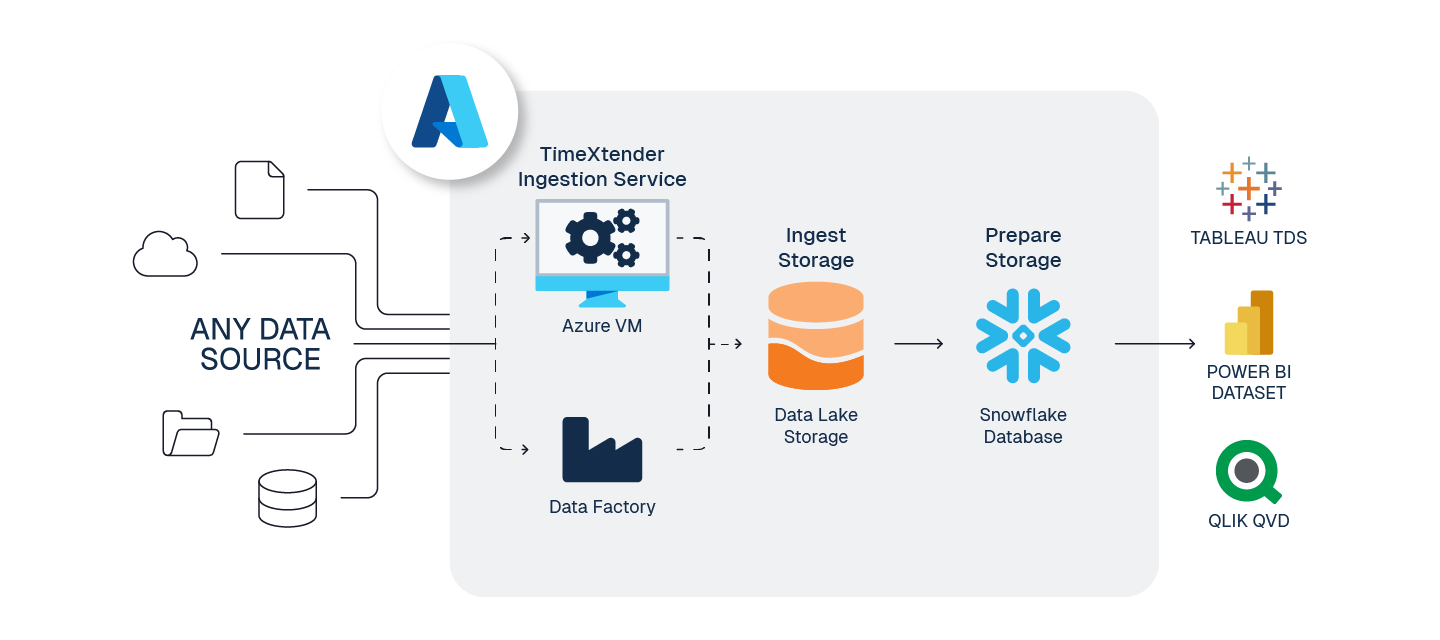This is a standard reference architecture to implement TimeXtender Data Integration fully in the cloud with Snowflake for data warehouse storage.
To prepare your TimeXtender Data Integration cloud environment, here are the steps we recommend.
1. Create Application Server - Azure VM
To serve the TimeXtender Data Integration application in Azure, we recommend using an Azure Virtual Machine (VM), sized according to your solution's requirements.
Guide: Create Application Server - Azure VM
Considerations:
- Recommended Sizing: DS2_v2 (for moderate workloads). See Azure VM Sizes documentation for more detail.
- This VM will host the below services, and must remain running for TimeXtender Data Integration to function
- TimeXtender Ingest Service
- TimeXtender Execution Service
2. Create Storage for Ingest instance - Azure Data Lake Storage Gen2
ADLS Gen2 is highly performant, economical, scalable, and secure way to store your raw data.
Guide: Create Ingest Storage - Azure Data Lake Storage Gen2
Considerations:
- When creating the ADLS Gen2 data lake service, you must enable Hierarchical Namespaces
- TimeXtender Data Integration writes files in Parquet file format, a highly compressed, columnar storage in the data lake.
- It is possible for Ingest Server to store data in Azure SQL DB (rather than in a data lake), but this adds cost and complexity but no additional functionality
- When using Azure Data Lake for the Ingest instance and SQL DB for the Prepare instance, it is highly recommended to use Data Factory to transport this data.
- ADLS will require a service principle, called App Registration in Azure, for TimeXtender Data Integration to access your ADF service.
- Both Data Lake and ADF, may share the same App Registration if desired.
3. Prepare for Ingest and Transport - Azure Data Factory (Optional)
For large data movement tasks, ADF provides amazing performance and ease of use for both ingestion and transfer.
Guide: Prepare for Ingest and Transfer - Azure Data Factory (recommended)
Considerations:
- When creating ADF resources use Gen2, which is the current default
- A single ADF service can be used for both transport and ingestion
- Ingestion from data source to Ingest Storage
- Transfer from Ingest instance to Prepare instance
- The option to use ADF is not available for all data source types, but many options are available.
- ADF Data sources do not support Ingest Query Tables at this time.
- ADF's performance can be quite costly for such incredible fault-tolerant performance
- ADF will require a service principle, called App Registration in Azure, for TimeXtender Data Integration to access your ADF service.
- Both Data Lake and ADF, may share the same App Registration if desired.
4. Create Storage for Prepare instance - Snowflake Database
- Snowflake’s multi-cloud compatibility allows users to deploy on AWS or GCP.
- Automatic usage-based scaling of compute and storage resource provides ideal cost/resource optimization.
- Suitable for medium to large data solutions. A great choice for mid-size data solutions (from 500GB and up), or in cases where estimated size of data solution is uncertain and/or might rapidly grow.
Guide: Use Snowflake for Prepare Instance Storage
5. Configure Power BI Premium Endpoint (Optional)
If you have Power BI Premium, deploy and execute semantic models within Deliver instances directly to the Power BI Premium endpoint.








